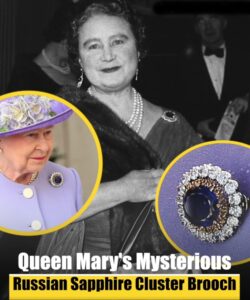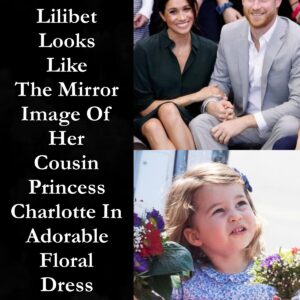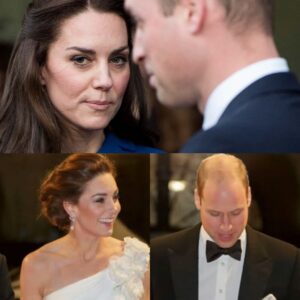Queen Mary’s Mysterious Russian Sapphire Cluster Brooch: A Jewel Steeped in History
The allure of royal jewelry lies not only in its dazzling beauty but also in the layers of history, mystery, and sentiment it carries. Among the British Royal Family’s extensive collection, Queen Mary’s Russian Sapphire Cluster Brooch stands out as a piece shrouded in intrigue.
Its rich blue sapphire, surrounded by a halo of diamonds, is more than just a breathtaking ornament—it’s a silent witness to a bygone era and a symbol of the enduring connections between royal houses.

The origins of the brooch are steeped in speculation. It is widely believed that the brooch was a gift from Tsar Nicholas II and Tsarina Alexandra of Russia, underscoring the close familial ties between the British and Russian monarchies.
Queen Mary, the grandmother of Queen Elizabeth II, was known for her impeccable taste in jewelry and her relentless passion for collecting historic pieces. This particular brooch, with its Russian provenance, would have held significant sentimental value for her, especially given the tragic fate of the Romanovs during the Russian Revolution.
The design of the brooch is a masterpiece of Edwardian elegance, reflecting the opulence of its era. The sapphire, thought to be of Russian origin, radiates a deep, mesmerizing blue, while the surrounding diamonds amplify its brilliance.
Its craftsmanship speaks to a time when jewelry was not merely an accessory but a statement of power, wealth, and international relations. For Queen Mary, wearing such a piece would have been a deliberate act, showcasing her connection to the Romanov dynasty while emphasizing the British monarchy’s enduring legacy.

Queen Mary was a master of using her jewelry to convey subtle messages. During her reign as consort to King George V, she often wore pieces that highlighted her family’s ties to other European royal houses, reinforcing the monarchy’s role in fostering international diplomacy. The Russian Sapphire Cluster Brooch, with its intricate design and poignant backstory, was likely one of her favorite tools for such symbolic gestures.
After Queen Mary’s death in 1953, the brooch passed into the collection of Queen Elizabeth II. Like her grandmother, Elizabeth recognized the significance of the piece and wore it on several occasions, often pairing it with blue ensembles that enhanced the sapphire’s striking hue. Each time she wore the brooch, it sparked renewed interest in its history and origins, yet the palace remained tight-lipped about its exact provenance, adding to its mystique.

The brooch’s association with the Romanovs has only deepened its allure over the years. Some historians suggest that it may have been part of a larger suite of jewels gifted to Queen Mary, while others believe it was acquired through private channels during the turmoil of the Russian Revolution, when many aristocratic families fled their homeland with their treasures. Regardless of its exact journey, the brooch stands as a poignant reminder of a world irreversibly altered by war and revolution.
Its presence in the British Royal Collection also highlights Queen Mary’s extraordinary foresight in preserving pieces of historical significance. She understood that royal jewelry was not merely ornamental but a vital part of the monarchy’s heritage. By carefully curating her collection, she ensured that future generations would not only inherit beautiful objects but also the stories and legacies they carried.

In modern times, the brooch continues to captivate royal watchers and jewelry enthusiasts alike. Its appearances are rare, which only heightens its mystique. Every time it emerges from the vaults, it serves as a testament to the enduring power of royal jewels to connect the past with the present. For the monarchy, it is more than a piece of adornment—it is a bridge between eras, a symbol of resilience, and a tribute to the complexities of history.

The Queen Mary Russian Sapphire Cluster Brooch, with its enigmatic origins and timeless beauty, remains one of the most fascinating pieces in the royal collection. It is a jewel that speaks volumes, not just through its radiant sapphire and diamonds but through the layers of history it represents. As it continues to dazzle in the 21st century, it reminds us that some mysteries are best left unsolved, their allure only growing with the passage of time.
News
Princess Lilibet Looks Like The Mirror Image Of Her Cousin Princess Charlotte In Adorable Floral Dress
Princess Lilibet Looks Like The Mirror Image Of Her Cousin Princess Charlotte In Adorable Floral Dress The Duke and Duchess of Sussex sent out their 2024 holiday card in late December 2024, and it’s been melting hearts ever since. The holiday card showcased six images that…
Meghan Markle Mourns Death of Rescue Beagle Guy: ‘I Have Cried Too Many Tears to Count’
Meghan Markle Mourns Death of Rescue Beagle Guy: ‘I Have Cried Too Many Tears to Count’ Guy, a rescue from a Kentucky kill shelter, has held a special place in the Duchess of Sussex’s heart since 2015 Meghan Markle; Meghan…
William and Kate Middleton “not as perfect as it seems”: Inside their rocky relationship
William and Kate Middleton “not as perfect as it seems”: Inside their rocky relationship Prince William and Kate Middleton have their ups and downs like any other relationship. It began in 2007 when the couple reportedly split up for various…
Bruce Springsteen, 74, gives alarming health update after postponing tour – and it confirms what we feared
Bruce Springsteen, 74, gives alarming health update after postponing tour – and it confirms what we feared Bruce Springsteen has had a rough time of it over the past few months, with his health issues forcing him to postpone all remaining…
Jon Bon Jovi and Dorothea Hurley: Rocking Compassion by Feeding the Homeless
Jon Bon Jovi and Dorothea Hurley: Rocking Compassion by Feeding the Homeless Jon Bon Jovi, a rock icon known for his powerful ballads and sold-out arenas, has proven time and time again that his heart is as big as his…
Uncommon images of Princess Diana, one of the most photographed people on Earth
Uncommon images of Princess Diana, one of the most photographed people on Earth Known as the People’s Princess because of her nurturing and compassionate nature, as well as love for the ordinary citizens, Lady Di will forever be remembered as…
End of content
No more pages to load











